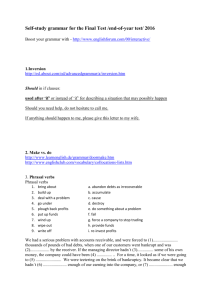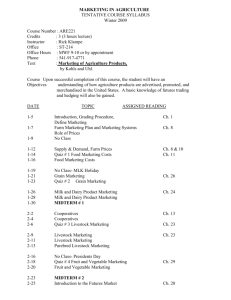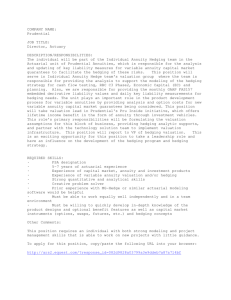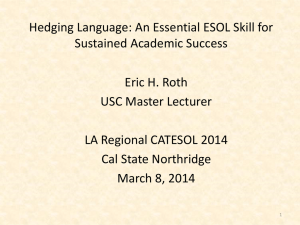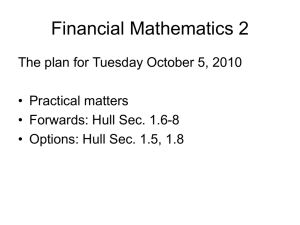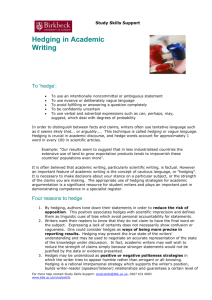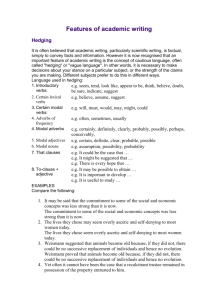Hedging vs. Forward Cash Contracting
advertisement
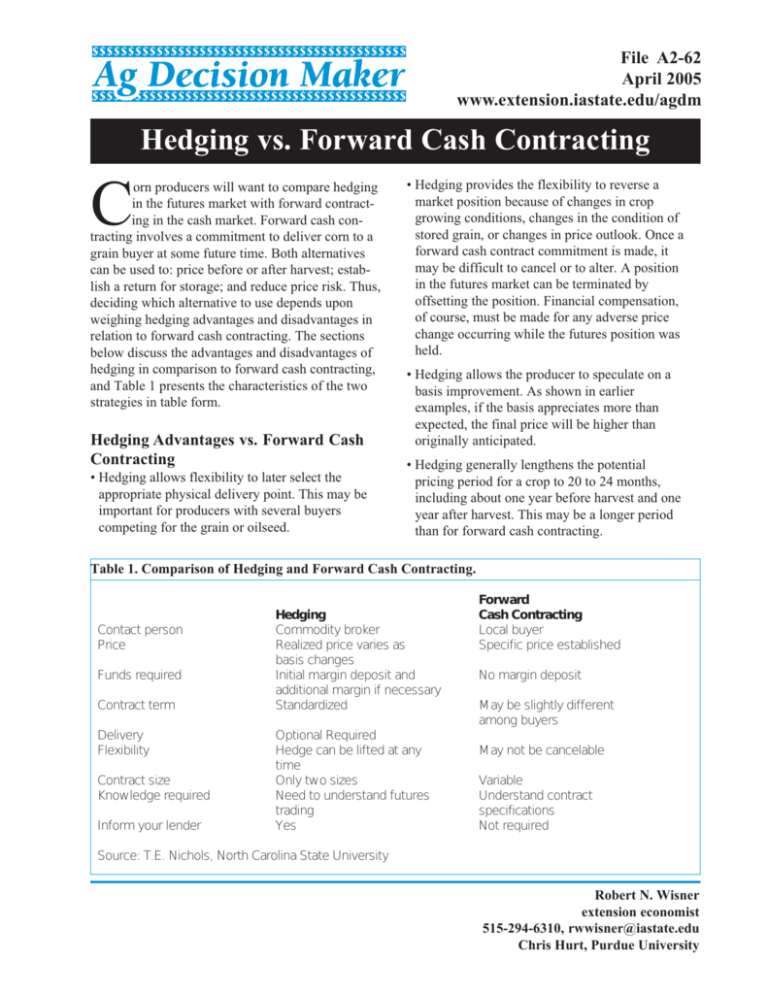
File A2-62 April 2005 www.extension.iastate.edu/agdm Hedging vs. Forward Cash Contracting C orn producers will want to compare hedging in the futures market with forward contracting in the cash market. Forward cash contracting involves a commitment to deliver corn to a grain buyer at some future time. Both alternatives can be used to: price before or after harvest; establish a return for storage; and reduce price risk. Thus, deciding which alternative to use depends upon weighing hedging advantages and disadvantages in relation to forward cash contracting. The sections below discuss the advantages and disadvantages of hedging in comparison to forward cash contracting, and Table 1 presents the characteristics of the two strategies in table form. Hedging Advantages vs. Forward Cash Contracting • Hedging allows flexibility to later select the appropriate physical delivery point. This may be important for producers with several buyers competing for the grain or oilseed. • Hedging provides the flexibility to reverse a market position because of changes in crop growing conditions, changes in the condition of stored grain, or changes in price outlook. Once a forward cash contract commitment is made, it may be difficult to cancel or to alter. A position in the futures market can be terminated by offsetting the position. Financial compensation, of course, must be made for any adverse price change occurring while the futures position was held. • Hedging allows the producer to speculate on a basis improvement. As shown in earlier examples, if the basis appreciates more than expected, the final price will be higher than originally anticipated. • Hedging generally lengthens the potential pricing period for a crop to 20 to 24 months, including about one year before harvest and one year after harvest. This may be a longer period than for forward cash contracting. Table 1. Comparison of Hedging and Forward Cash Contracting. Contact person Price Funds required Contract term Delivery Flexibility Contract size Knowledge required Inform your lender Hedging Commodity broker Realized price varies as basis changes Initial margin deposit and additional margin if necessary Standardized Optional Required Hedge can be lifted at any time Only two sizes Need to understand futures trading Yes Forward Cash Contracting Local buyer Specific price established No margin deposit May be slightly different among buyers May not be cancelable Variable Understand contract specifications Not required Source: T.E. Nichols, North Carolina State University Robert N. Wisner extension economist 515-294-6310, rwwisner@iastate.edu Chris Hurt, Purdue University Page 2 Hedging Disadvantages vs. Forward Cash Contracting • In hedging, the final cash price initially is not known for certain because the final basis is not known until the hedge is converted to a cash sale. • Hedging is more complex then forward cash contracting. To hedge successfully, producers must understand futures markets, cash markets, and basis relationships. They must trade in the futures market and will have to involve more people such as a commodity broker and a lender in their market decision making. • Margin money is required to maintain a position in the futures market. A forward cash contract typically does not require margin deposits. • Hedging involves extra marketing cost, including brokerage commissions and interest on margin money. These extra costs may average 0.5 to 2 cents per bushel. • Since hedging involves using futures contracts, corn can only be sold in 5,000 bushel lots (Chicago Board of Trade) or in 1,000 bushel lots (Mid-American Commodity Exchange, also in Chicago). The 1,000 bushel futures contracts are often referred to as “mini-contracts.” • Basis levels may not gain as expected. A basis level weaker than anticipated will provide a lower final price than expected. The Lender’s Role in Hedging Agricultural lenders play a potentially important role in grain producer hedging. Many lenders are willing to finance margin accounts for bonafide hedgers, since hedging reduces the exposure to price risk. Some will also lend a larger percentage of the value of stored grain if it is hedged rather than held unpriced. Lending 90% of the hedged value of stored corn is a common practice. Lenders also may help farm clients evaluate how various hedging opportunities will influence the farm’s financial condition and help them determine an acceptable level of price risk. File A2-62 Some agricultural lenders utilize three-way hedging agreements between producer, broker, and lender. In this arrangement, the brokerage house sends any margin calls to the lending institution. The lender then automatically lends the producer the amount needed to cover margin requirements and sends the margin deposit to the brokerage firm. In this way, the corn producer is assured that funds will be available for the margin account. In case of profits in the futures position, these are automatically sent to the lending institution to be invested in an interest-earning account for the producer. Three-way agreements also tend to reduce the psychological stress a producer may face when receiving margin calls. The producer receives copies of all transactions. Hedging Summary Hedging can greatly reduce the exposure to price risk. It is an important marketing tool for establishing price while retaining considerable marketing flexibility. However, hedging does not guarantee a profit. The hedging decision must still take into account production costs and market outlook. For many producers, deciding when to hedge is one of the most difficult aspects of grain marketing. Pricing indecision often leads to a “donothing-until-forced-to-sell strategy,” with the crop sometimes sold at low prices. An understanding of market alternatives such as hedging can help avoid such problems and lead to a more successful grain marketing program. Additional literature on hedging for corn producers can be obtained from: Chicago Board of Trade 141 West Jackson Blvd. Chicago, Illinois 60604 The Cooperative Extension Service at your land grant university Commodity brokerage firms Revised 5/2002 - Cooperative Extension Work in Agriculture and Home Economics, State of Indiana, Purdue University and U.S. Department of Agriculture Cooperating. H.A. Wadsworth, Director, West Lafayette, IN. Issued in furtherance of the Acts of May 8 and June 30, 1914. It is the policy of the Cooperative Extension Service of Purdue University that all persons shall have equal opportunity and access to our programs and facilities.

